Growing Piel de Sapo Melon in the orchard: Complete guide
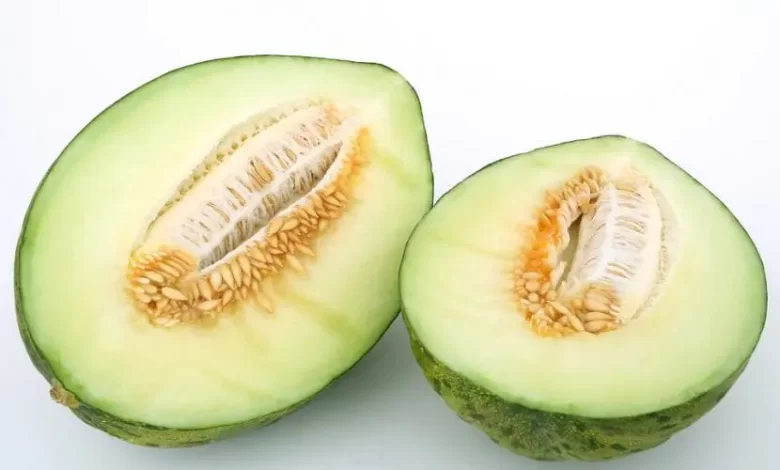
Very good to all Agrohuertisters. Today in Agrohuerto we are going to see how the Piel de Sapo melon crop went in your favorite orchard and everything that I have learned after the first harvest.
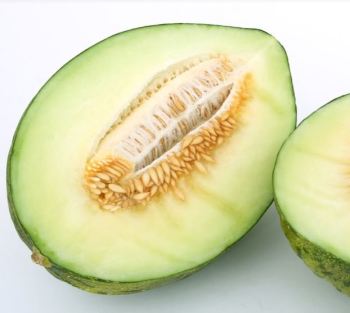
The Piel de Sapo melon is a very Spanish variety that is known, as far as I have been able to verify, quite a bit in other countries. A shame really because this melon is very very sweet and » easy to grow», you just need enough space.
Cultivation of the Piel de Sapo Melon
The bush of this type of melon expands «runs» a lot, since it is a creeping species and it is necessary to have a large separation between bushes, about 0.5 m, so that each plant has adequate space for its development, more or less 1 m 2 of surface per floor. In other books it is said that 0.4 m 2 is enough space for this variety, I left 1 m 2 and as you can see in the previous video, it is not that I had space left over…
In the case of this variety, pruning is not recommended or necessary according to the experience that local farmers in my town gave me, who have been growing these melons for many, many years, even so if you have a relatively fair space for growing melons you can carry out this type of pruning to control its growth and facilitate the ripening and filling of the fruits:
Toad skin melon pruning
Creeping pruning: When the plant already has 4 or 5 leaves, the main stem of the plant usually begins to sprout above the second or third leaf, that stem is cut or stands out. So far so good, now from the axils of the remaining leaves (the axils are the elbows that come out of the main stem and end up giving rise to lateral stems) lateral stems will come out, worth the redundancy, because when these stems have about 5 or 6 leaves they are cut above the third leaf.
From the axils of the remaining leaves, new lateral stems will grow that are fruitful, so pruning these is optional above the second leaf.
I hope you have found out more or less, I leave you this image of cucumber pruning that will surely clarify things for you:
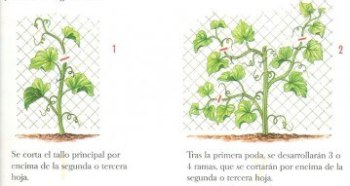
Where to grow Piel de Sapo melon
As I have already told you, the cultivation of a Piel de Sapo melon basically depends on the space you have, now it is also advisable to cultivate them in a plot located in a warm and not very humid climate, which is why Castilla-La Mancha is the first producer of this type of melon so characteristic for its green rind with dark spots similar to the skin of an amphibian.
The fruits of the Piel de Sapo variety are also characterized by being very uniform in terms of size, weight and quality. They are usually elongated, very sweet, not very fragrant and weigh between 1.5 and 2.5 kg, although they all weighed much more for me, reaching melons of up to 6 or 7 kg.
Piel de Sapo melon: diseases
Now, as I have told you many times, this garden is a bit of trial and error, you always have to keep the good things and learn from mistakes. That is why I see something positive that the powdery mildew attacked the melon grove, so I can tell you about my experience and that the same thing happens to you.
As you can see in the previous video I hate it, that one of the most common garden fungi, manifests itself through small white spots on the leaves. These spots later spread until the entire melon area is covered with a kind of dust (which are still spores of the fungus) causing the plant to develop poorly, the roots not to develop correctly and finally the bush to finish. drying up.
It is very sad to approach the orchard and see such a panorama, the leaves and fruits are mummified, old, obsolete due to the white dust, it gives the sensation of entering a basement or an attic that has been closed for years and years.
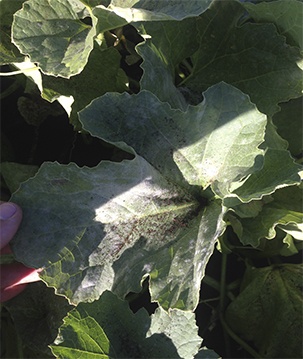
Mushrooms in the melon: ecological treatments
To combat the fungus in an ecological way, prevention is recommended in the first instance, mainly removing nearby weeds, the remains of previous crops and not planting other species of cucurbits to avoid sources of the disease. It is also recommended not to water excessively to control the humidity of the crop and hinder the optimal conditions for the development of a fungus. I fulfilled all these parameters but the damn powdery mildew did not stop invading me, possibly because the spores are transmitted through the air and I was unlucky.
Once you are invaded you can use effective shock techniques such as applying sulfur, in its different formats, but I personally don’t feel like eating something that has been treated with that mineral. So I decided not to treat the melon, due to the fungus, the melons did not finish their growth optimally, losing a point of flavor during filling, but at least they did not contain chemicals.
How to grow melon in the garden
Call me cynical because surely what I eat every day has been treated with worse things, but if I can choose between a tasteless, ecological and untreated melon and another melon with more flavor but treated with chemicals, I’ll stick with the tasteless one, I can always add something to it of ham to give it the touch
References
- Braun, U. (1980).Morphological Studies in the Genus Oidium. Flora. 170(1–2), 77-90.
- Polak, E., Aebi, M., KÜES, U. (2001).Morphological variations in oidium formation in the basidiomycete Coprinus cinereus.MycologicalResearch. 105(5), 603-610.
- Lecoq, H., Desbiez, C. (2012). Chapter 3 – Viruses of Cucurbit Crops in the Mediterranean Region: An Ever-Changing Picture. Editor(s): Gad Loebenstein, Hervé Lecoq, Advances in Virus Research, Academic Press, 84, 67-126.
Little more, I hope you have enjoyed the video and these tips will help you a lot.
Greetings

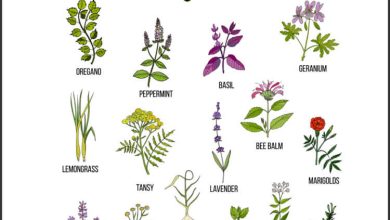
![Photo of Vriesea: [Characteristics, Cultivation, Care and Disadvantages]](https://www.complete-gardening.com/wp-content/uploads/2022/08/vriesea-characteristics-cultivation-care-and-disadvantages-390x220.jpg)

